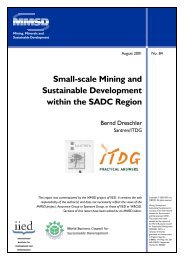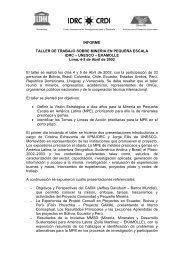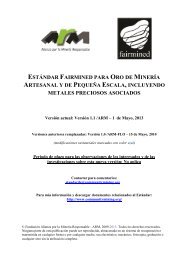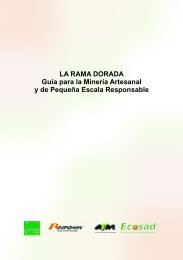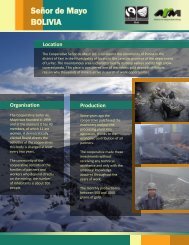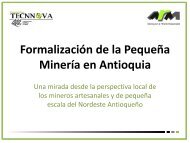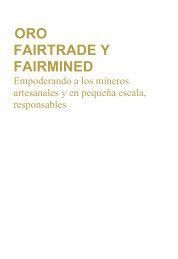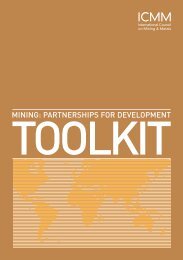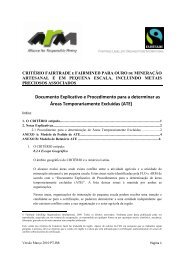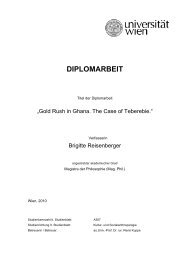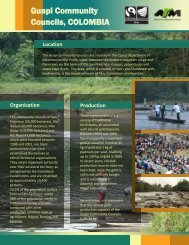A Poisonous Mix - Human Rights Watch
A Poisonous Mix - Human Rights Watch
A Poisonous Mix - Human Rights Watch
Create successful ePaper yourself
Turn your PDF publications into a flip-book with our unique Google optimized e-Paper software.
Agriculture and domestic labor are the most common forms of child labor in Mali. 200 Boys<br />
frequently work in agriculture, sometimes leaving the mines during the harvest. Others<br />
work entirely in agriculture. 201<br />
Many girls in mining communities do domestic labor, in their own families or the host<br />
families they live with. 202 While most of the domestic work is done in the home, some<br />
takes place at the mine. Women often take smaller children with them to the mine because<br />
they lack childcare, and use their older children to look after the small siblings. 203 Children<br />
frequently have to carry younger siblings on their back, feed them, and protect them from<br />
injury. In one case, a mother told us that her four-year-old daughter was looking after her<br />
little sister in the mine. 204<br />
Children also work in other businesses. For example, they sell water or food, or make<br />
bricks or clothing. 205 In addition, children are involved in sex work, one of the worst forms<br />
of child labor. 206<br />
Attitudes to Child Labor<br />
Child labor is common and is widely accepted in Mali. A recent survey on attitudes towards<br />
child labor confirms that parents commonly view child labor as acceptable. 207 Teaching a<br />
child how to mine gold is considered part of socialization. 208 Government officials also told<br />
<strong>Human</strong> <strong>Rights</strong> <strong>Watch</strong> that child labor was part of Malian culture. A ministry official described<br />
child labor as “educative” (socialisant), as it teaches children the value of work. 209<br />
200 On child labor in Mali, see section I.<br />
201 <strong>Human</strong> <strong>Rights</strong> <strong>Watch</strong> interview with Abderrahmane S., age 14, Baroya, April 3, 2011; <strong>Human</strong> <strong>Rights</strong> <strong>Watch</strong> interview with Julani M.,<br />
estimated age 16, Worognan, April 8, 2011; <strong>Human</strong> <strong>Rights</strong> <strong>Watch</strong> interview with Alexandre A., age 11, Worognan, April 8, 2011.<br />
202 <strong>Human</strong> <strong>Rights</strong> <strong>Watch</strong> interview with school director and teacher from Sensoko, Kéniéba, April 2, 2011; <strong>Human</strong> <strong>Rights</strong><br />
<strong>Watch</strong> interview with Evelyne, age 9, Baroya, April 3, 2011; <strong>Human</strong> <strong>Rights</strong> <strong>Watch</strong> interview with Rokia K., age 13, Baroya, April<br />
3, 2011; <strong>Human</strong> <strong>Rights</strong> <strong>Watch</strong> interview with Fanta D., age 12, Baroya, April 3, 2011; <strong>Human</strong> <strong>Rights</strong> <strong>Watch</strong> interview with<br />
Kadiatou K., age 11, Baroya, April 3, 2011. On child domestic labor in neighboring Guinea and the use of Malian girls there,<br />
see <strong>Human</strong> <strong>Rights</strong> <strong>Watch</strong>, Bottom of the Ladder: Exploitation and Abuse of Girl Domestic Workers in Guinea, June 2007,<br />
http://www.hrw.org/en/reports/2007/06/14/bottom-ladder-0.<br />
203 <strong>Human</strong> <strong>Rights</strong> <strong>Watch</strong> interview with school director and two teachers, Baroya, April 3, 2011; <strong>Human</strong> <strong>Rights</strong> <strong>Watch</strong> interview with<br />
Moctar, age eight, Tabakoto, April 2, 2011; <strong>Human</strong> <strong>Rights</strong> <strong>Watch</strong> interview with Anne M., 10, Baroya, April 3, 2011.<br />
204 <strong>Human</strong> <strong>Rights</strong> <strong>Watch</strong> interview with woman gold miner, Tabakoto, April 2, 2011.<br />
205 <strong>Human</strong> <strong>Rights</strong> <strong>Watch</strong> interview with Binta M., age 15, Worognan, April 9, 2011; <strong>Human</strong> <strong>Rights</strong> <strong>Watch</strong> interview with<br />
Christine, age 17, Worognan, April 9, 2011; <strong>Human</strong> <strong>Rights</strong> <strong>Watch</strong> interview with Rokia K., age 13, Baroya, April 3, 2011.<br />
206 On sex work, see section IV.<br />
207 ILO/IPEC, “Etude CAP”, p. 46.<br />
208 On child labor as social practice, see Loretta E. Bass, Child Labor.<br />
209 <strong>Human</strong> <strong>Rights</strong> <strong>Watch</strong> interview with representative of the National Statistics Institute (INSTAT), Bamako, April 6, 2011. An<br />
official of the Mining Chamber spoke of child labor as “socialization.” <strong>Human</strong> <strong>Rights</strong> <strong>Watch</strong> interview with legal advisor, Mali<br />
Mining Chamber, Bamako, April 11, 2011.<br />
A POISONOUS MIX 48



